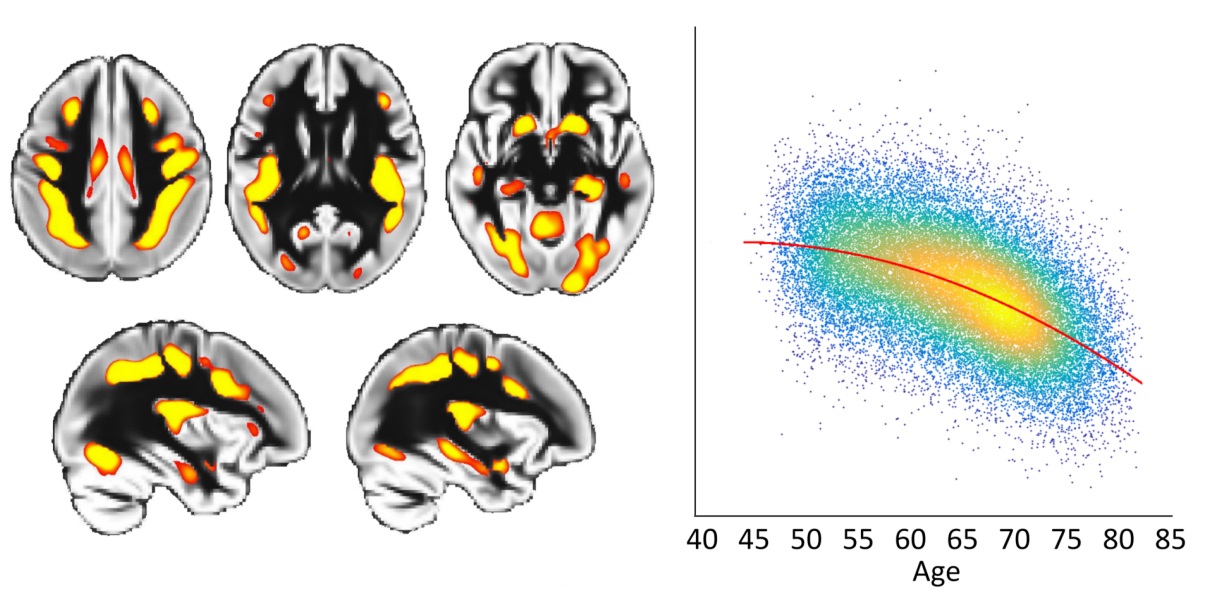
Image credit: Shutterstock
Risk factors for faster aging in the brain revealed in new study
Researchers from the Nuffield Department of Clinical Neurosciences at the University of Oxford have used data from UK Biobank participants to reveal that diabetes, traffic-related air pollution and alcohol intake are the most harmful out of 15 modifiable risk factors for dementia.
The researchers had previously identified a ‘weak spot’ in the brain, which is a specific network of higher-order regions that not only develop later during adolescence, but also show earlier degeneration in old age. They showed that this brain network is also particularly vulnerable to schizophrenia and Alzheimer’s disease.
In this new study, published in Nature Communications, they investigated the genetic and modifiable influences on these fragile brain regions by looking at the brain scans of 40,000 UK Biobank participants aged over 45.
The researchers examined 161 risk factors for dementia, and ranked their impact on this vulnerable brain network, over and above the natural effects of age. They classified these so-called ‘modifiable’ risk factors − as they can potentially be changed throughout life to reduce the risk of dementia − into 15 broad categories: blood pressure, cholesterol, diabetes, weight, alcohol consumption, smoking, depressive mood, inflammation, pollution, hearing, sleep, socialisation, diet, physical activity, and education.
Professor Gwenaëlle Douaud, who led this study, said: ‘We know that a constellation of brain regions degenerates earlier in aging, and in this new study we have shown that these specific parts of the brain are most vulnerable to diabetes, traffic-related air pollution − increasingly a major player in dementia − and alcohol, of all the common risk factors for dementia.’
‘We have found that several variations in the genome influence this brain network, and they are implicated in cardiovascular deaths, schizophrenia, Alzheimer’s and Parkinson’s diseases, as well as with the two antigens of a little-known blood group, the elusive XG antigen system, which was an entirely new and unexpected finding.’

Image caption: To the left of the figure, the red-yellow colour denotes the regions that degenerate earlier than the rest of the brain, and are vulnerable to Alzheimer’s disease. These brain areas are higher-order regions that process and combine information coming from our different senses. To the right of the figure, each dot represents the brain data from one UK Biobank participant. The overall curve shows that, in these particularly fragile regions of the brain, there is accelerated degeneration with age. Credit: G. Douaud and J. Manuello.
Professor Lloyd Elliott, a co-author from Simon Fraser University in Canada, concurs: ‘In fact, two of our seven genetic findings are located in this particular region containing the genes of the XG blood group, and that region is highly atypical because it is shared by both X and Y sex chromosomes. This is really quite intriguing as we do not know much about these parts of the genome; our work shows there is benefit in exploring further this genetic terra incognita.’
Importantly, as Professor Anderson Winkler, a co-author from the National Institutes of Health and The University of Texas Rio Grande Valley in the US, points out: ‘What makes this study special is that we examined the unique contribution of each modifiable risk factor by looking at all of them together to assess the resulting degeneration of this particular brain ‘weak spot’. It is with this kind of comprehensive, holistic approach − and once we had taken into account the effects of age and sex − that three emerged as the most harmful: diabetes, air pollution, and alcohol.’
This research sheds light on some of the most critical risk factors for dementia, and provides novel information that can contribute to prevention and future strategies for targeted intervention.
The paper ‘The effects of genetic and modifiable risk factors on brain regions vulnerable to ageing and disease’ is published in Nature Communications.
This research was funded by the UK Medical Research Council and the Wellcome Trust. The study was led by Professor Gwenaëlle Douaud, from the Wellcome Centre for Integrative Neuroimaging (WIN), an Associate Professor at the Nuffield Department of Clinical Neurosciences (NDCN) and Research Fellow at Green Templeton College,
 New Year Honours 2026
New Year Honours 2026
 New study estimates NHS England spends 3% of its primary and secondary care budget on the health impacts of temperature
New study estimates NHS England spends 3% of its primary and secondary care budget on the health impacts of temperature
 International collaboration launches largest-ever therapeutics trial for patients hospitalised with dengue
International collaboration launches largest-ever therapeutics trial for patients hospitalised with dengue
 Oxford-built multi-agent assistant for cancer care to be piloted in collaboration with Microsoft
Oxford-built multi-agent assistant for cancer care to be piloted in collaboration with Microsoft